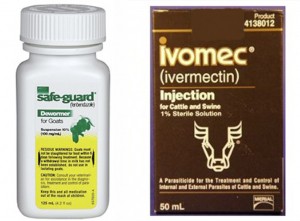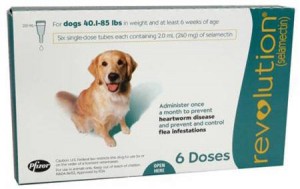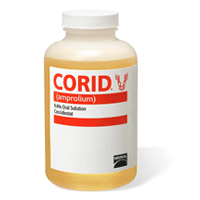A good health care program includes trimming nails, brushing their fur at least weekly and daily during times of molting (twice each year), making sure their eyes, nose, feet, bums, and skin are clean and free from infection, keeping an eye on their teeth, watching for possible signs of disease, and implementing an effective deworming plan that meets the needs of your rabbit. Below are examples of measures that we use to keep our Hollands healthy.
Deworm
 For de-worming, liquid Fenbendazole/Safe-guard suspension wormer (100 mg/mL) at a rate of .2cc per lb in the spring and fall, administering orally once a day for five days, is an effective pinworm treatment. As a preventative measure after large shows, Fenbendazole can be administered once at a rate of .1cc per lb. Safe-Guard, manufactured by Intervet/Farnam, is commonly available for purchase from local Ag/Feed stores and is packaged in a bottle marked “for Goats”; this is the same strength and product we purchased from our vet to deworm our rabbits.
For de-worming, liquid Fenbendazole/Safe-guard suspension wormer (100 mg/mL) at a rate of .2cc per lb in the spring and fall, administering orally once a day for five days, is an effective pinworm treatment. As a preventative measure after large shows, Fenbendazole can be administered once at a rate of .1cc per lb. Safe-Guard, manufactured by Intervet/Farnam, is commonly available for purchase from local Ag/Feed stores and is packaged in a bottle marked “for Goats”; this is the same strength and product we purchased from our vet to deworm our rabbits.
Before the harsh and stressful temperature changes of winter and spring, we often deworm by treating with Ivomec, a 1% injectable solution made for cattle and swine, at a rate of .1cc per lb administered orally to help keep minimize the advancement of opportunistic protozoans commonly found within the system. While probiotics, like Ben-Bac, Fastrack, or Probios, may help rabbits maintain gut flora when being treated for worms, we actually prefer using pre-biotics, like Bio-Mos, because they are much more effective at improving vital hind gut flora in rabbits. Administering prebiotics or probiotics orally starting a day or two before worming to two or three days post any medical treatment that can alter the gastrointestinal flora is very helpful. It’s been our experience that rabbits tolerate the Safe-Guard a little easier than Ivomec, but both are well tolerated when dosed appropriately. As always, provide unlimited fresh quality hay and water when treating for worms and consult with your vet to obtain the best possible treatment plan to meet your rabbit’s needs.
Please note: be careful not to overdose with Ivomec, doing so could result in liver damage and fatality. In addition, Ivomec can be used to induce a molt or to finish a molt that is already in progress.
Fur Mites
 In certain regions or during times when fur mites are a problem, treating with “Revolution” (available from your vet) at a dosage rate of 6-10 mg/kg per pound of body weight, applied topically between the shoulder blades for 1x/month for 1-2 months, will usually eradicate mites while effectively worming your rabbit also. Using the lowest suggested dosage rate by our vet (6 mg/kg per pound), the application rate comes out to .025cc of Revolution per pound (or .1cc for a 4 pound Holland). We’ve found it’s more cost effective to buy the teal colored box (treats 40-80 lb dogs) that has three 2.0ml tubes (240 mg/each tube). This is enough Revolution for twenty 4 lb rabbit applications in each tube (or sixty applications per box)…and as an added perk, Revolution’s shelf life is forever. Simply draw up the solution from the tube using a 1cc syringe and then remove the needle tip from the syringe so the solution can be administered topically, as needed by weight, for each rabbit infected or for prevention (summer show season). Using 1% Ivomec Cattle Injectable (given orally at the deworming dosage rate above) to treat/prevent mites is also helpful, but not quite as effective since Ivomec is eliminated from the system much faster (week) than the Revolution (30 days). Please consult with your vet to obtain the best possible treatment plan to meet your rabbit’s individual and environmental needs.
In certain regions or during times when fur mites are a problem, treating with “Revolution” (available from your vet) at a dosage rate of 6-10 mg/kg per pound of body weight, applied topically between the shoulder blades for 1x/month for 1-2 months, will usually eradicate mites while effectively worming your rabbit also. Using the lowest suggested dosage rate by our vet (6 mg/kg per pound), the application rate comes out to .025cc of Revolution per pound (or .1cc for a 4 pound Holland). We’ve found it’s more cost effective to buy the teal colored box (treats 40-80 lb dogs) that has three 2.0ml tubes (240 mg/each tube). This is enough Revolution for twenty 4 lb rabbit applications in each tube (or sixty applications per box)…and as an added perk, Revolution’s shelf life is forever. Simply draw up the solution from the tube using a 1cc syringe and then remove the needle tip from the syringe so the solution can be administered topically, as needed by weight, for each rabbit infected or for prevention (summer show season). Using 1% Ivomec Cattle Injectable (given orally at the deworming dosage rate above) to treat/prevent mites is also helpful, but not quite as effective since Ivomec is eliminated from the system much faster (week) than the Revolution (30 days). Please consult with your vet to obtain the best possible treatment plan to meet your rabbit’s individual and environmental needs.
Intestinal Disease
 Coccidiosis is a common and serious disease in rabbits, in which the liver and intestine can be affected. Since the disease is caused by opportunistic pathogens, the symptoms of coccidiosis often occur during times of stress. The risk of infection is actually higher for growing/young kits than adults, and kits are especially susceptible during stressful periods, including transitioning onto solid foods and post weaning. Symptoms of the disease include diarrhea, fever, lack of appetite, fading or weight loss, emaciation, and death. Older rabbits, however, often become resistant to the disease, but they can be carriers and serve as sources of infection to younger rabbits. For these reason and because coccidia is highly contagious, entire herd prevention methods are highly recommended. Common prevention includes the oral administration of Corid (Amprolium) 9.6% solution in the spring (before the weather gets warm) and fall (before the temps get cool). Merial, the manufacturer of Corid, suggests mixing 1 teaspoon of Corid 9.6% liquid solution with 1 gallon of water and offering this as the sole source of water for 5 days. Many experienced breeders and judges, however, treat using this mixture twice a year (before temperature changes in the fall and spring) for 5 days, discontinue treatment for 10 days, and then repeat the treatment for an addition 5 days. Please visit Merial’s site for Coccidia information and, as always, consult with a qualified veterinarian for the best possible treatment and prevention programs for your herd.
Coccidiosis is a common and serious disease in rabbits, in which the liver and intestine can be affected. Since the disease is caused by opportunistic pathogens, the symptoms of coccidiosis often occur during times of stress. The risk of infection is actually higher for growing/young kits than adults, and kits are especially susceptible during stressful periods, including transitioning onto solid foods and post weaning. Symptoms of the disease include diarrhea, fever, lack of appetite, fading or weight loss, emaciation, and death. Older rabbits, however, often become resistant to the disease, but they can be carriers and serve as sources of infection to younger rabbits. For these reason and because coccidia is highly contagious, entire herd prevention methods are highly recommended. Common prevention includes the oral administration of Corid (Amprolium) 9.6% solution in the spring (before the weather gets warm) and fall (before the temps get cool). Merial, the manufacturer of Corid, suggests mixing 1 teaspoon of Corid 9.6% liquid solution with 1 gallon of water and offering this as the sole source of water for 5 days. Many experienced breeders and judges, however, treat using this mixture twice a year (before temperature changes in the fall and spring) for 5 days, discontinue treatment for 10 days, and then repeat the treatment for an addition 5 days. Please visit Merial’s site for Coccidia information and, as always, consult with a qualified veterinarian for the best possible treatment and prevention programs for your herd.




